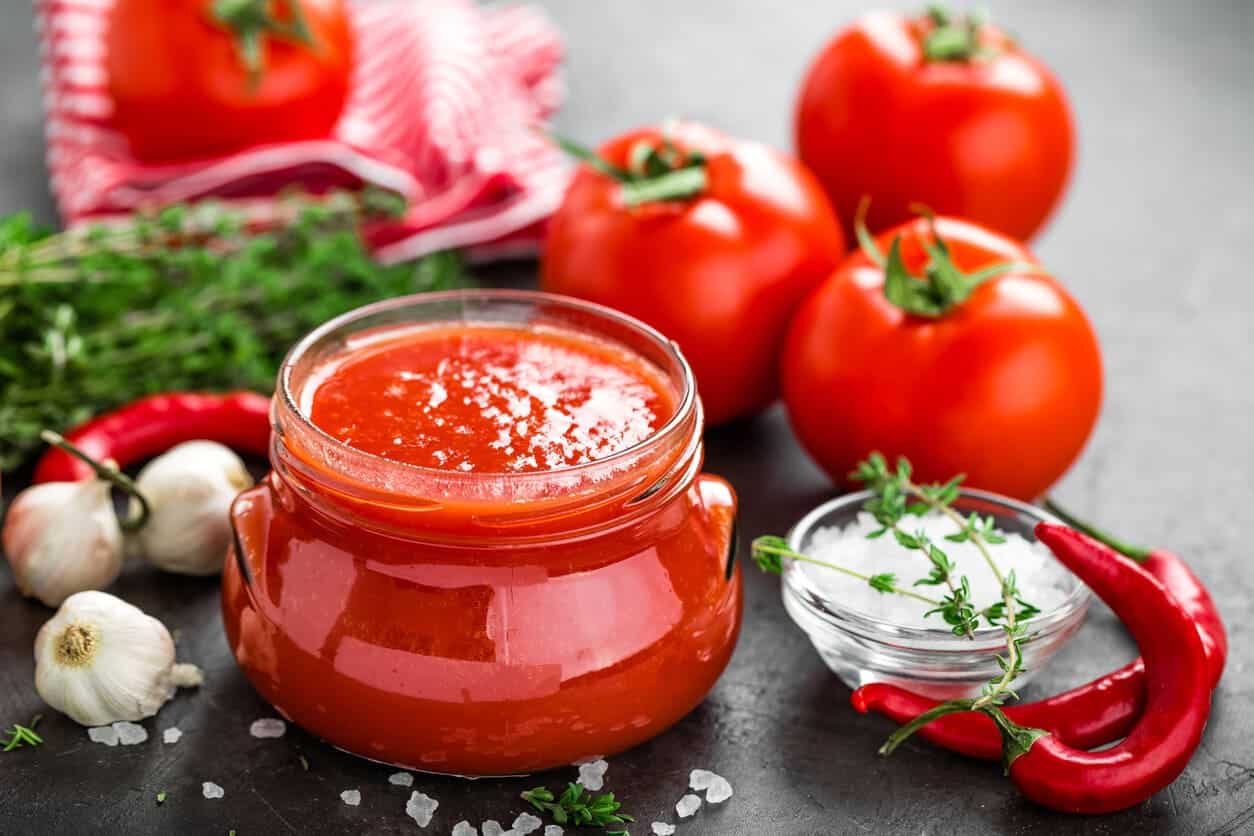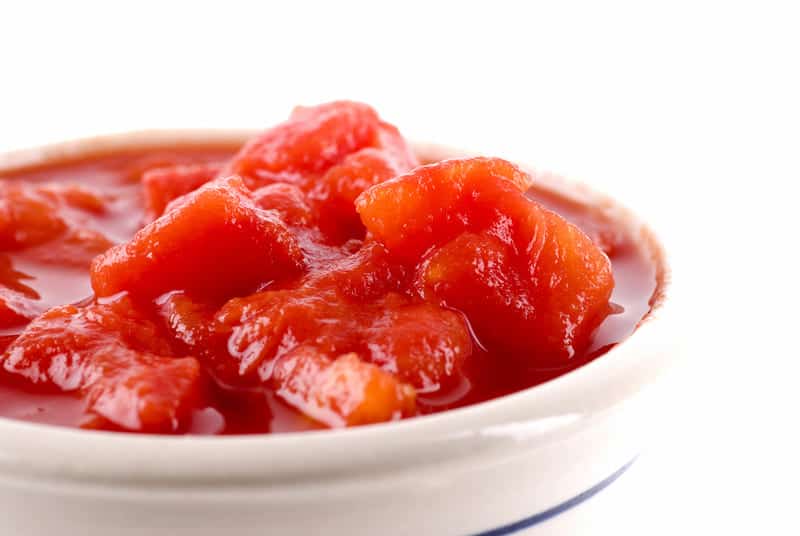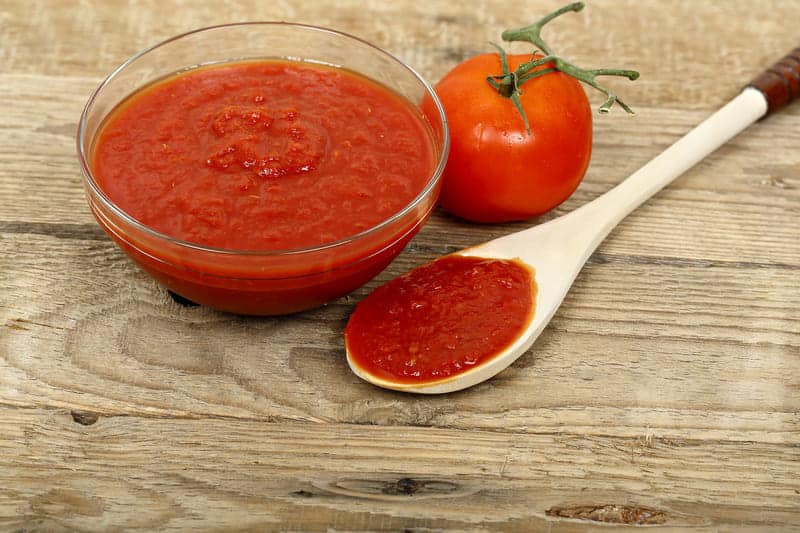If you’ve ever wondered what’s the difference between crushed tomatoes and tomato puree, or which one to use when cooking a certain dish, this post will illustrate the key differences between them.
Crushed tomatoes and tomato puree differ primarily in their method of preparation and consistency; crushed tomatoes are typically canned, made from fresh, whole tomatoes with chunky parts. Tomato puree, on the other hand, is the thick red liquid left behind after tomatoes have been cooked and strained.
Tomatoes have many health benefits. They are an excellent source of vitamins A and C, and are packed with lycopene – an antioxidant that helps keep your heart healthy.
A staple in many cuisines, tomatoes can be grown in a home garden or easily procured in the market – fresh, canned, in jars or tetra pack.
They may simply be cut up and served in salads, pasta, hors d’oeuvres, or as garnish without the need to cook them. They also make hearty bases for sauces, stews, curries, and casseroles.
Whatever the culinary purpose, distinguishing between the different products available can be challenging to discern what and when to add them to a recipe.
Let me tell you more about crushed tomatoes and tomato puree, their best cooking uses and how to make each one from scratch.

Crushed Tomatoes vs. Tomato Puree
Although they contain a similar star ingredient – the tomato, crushed tomato, and tomato puree have different methods of preparation and consistency.
Crushed tomato is prepared with uncooked, whole, fresh tomatoes while cooked, and blended tomatoes make tomato puree.
Crushed tomatoes are lightly processed, and sterilized in cans to preserve their garden-fresh flavor. Pulpy, chunky, and with a watery liquid, canned tomatoes may contain tomato puree or paste.
Tomato puree, on the other hand, is a thick liquid made by briefly cooking tomatoes. It goes through a filter to provide a finer and smoother texture than crushed tomatoes and tomato sauce, but thicker than concentrated tomato paste.
While tomato puree tends to be smooth, crushed tomatoes are chunky in appearance. Both are suitable for use in soups, stews, and sauces, but tomato puree has more pronounced flavors from the herbs and seasonings that were added to it.
Tomato puree is your go-to if you need to add body, a bold flavor, and color to dishes while crushed tomatoes add substance and a fresh flavor
Crushed tomatoes and tomato puree are two comparable ingredients that serve different purposes.
They may be interchangeable but without altering the recipe, chances are the sauce may be either too thin or soggy or too thick and paste-y.
To illustrate crushed tomato versus tomato puree:
| Crushed Tomato | Tomato Puree | |
| Main Ingredient | Fresh whole tomatoes | Fresh whole tomatoes |
| Preparation Process | Raw or lightly processed when canned | Cooked briefly |
| Other Production Process | Blended, pulped, grated, mashed, crushed | Blended or passes through a sieve |
| Texture | Chunky | Smooth and Thick |
| Taste | Fresh | Cooked taste |
| Consistency | Chunky with liquid juice | Fine, not watery |
| Seasoning | Unseasoned to lightly seasoned | Unseasoned to lightly seasoned |
| Pre-made availability | Canned | Canned, Tetra-pack |
When you can’t get perfectly ripened fresh tomatoes to make crushed tomatoes, canned versions are widely available in groceries.
Canned crushed tomatoes are picked before fully ripened to help in preservation. The most popular tomato cultivars are Roma and San Marzano tomatoes prized for their high ratios of flesh to juice.
They are used in everyday cooking for convenience and simple substitutes can be made from ingredients found in your cupboard.
Here’s how to make crushed tomatoes from fresh tomatoes:
You will need to select the freshest tomatoes that you have. This will yield the best flavor. If making a trip to the market, choose tomatoes that are ripe, indicated by soft flesh and bright skin.
- Rinse the tomatoes properly.
- Then peel your tomatoes. You may or may not want to keep the skins on for your crushed tomatoes. If you prefer to keep them on, skip this step.
- Remove blemishes, and stems and cut out the core.
- Next, cut the tomatoes in quarters. Deseed them or choose to leave some on.
- Dunk them in a food processor or blender. Blitz for a few seconds to leave chunkier bits in the crushed tomatoes.
- Alternatively you can crush them with your hand or a meat tenderizer although this procedure can get messy with lots of tomato juices squirting in all directions.
- Add a small amount of tomato paste to increase the thin consistency, and lend a bright crimson hue.
- Depending on how you will use your crushed tomatoes next, you can season them, cook them in a pan, or squeeze lemon juice into them as a step before canning.
If preparing it from scratch isn’t your thing, you can use another canned tomato alternative that you might already have on hand.
High-quality canned tomatoes are premium ingredients in any pantry. Quality tomato products have a richness to them that makes them ideal for any gastronomic application.
Use diced or whole canned tomatoes as a substitute. Whole is the highest quality among all canned tomato products. It’s generally sold peeled, in either juice or puree. Diced canned tomatoes are whole tomatoes that have been chopped up in chunks.
To reach the texture of crushed tomatoes, blitz them up for a few seconds in the food processor or crush them with your fist.
To make the sauce somewhat thicker, add tomato paste.

Culinary uses for crushed tomatoes
Having a supply of canned crushed tomatoes on hand is always helpful. If you want a chunkier consistency in your soups, stews, casseroles, and sauces, crushed tomatoes are fantastic.
Nothing beats fresh when making recipes that require raw tomatoes like salsa or gazpacho. But crushed tomatoes offer great flavor and freshness; squeeze some lemon to taper the acidity and “tinned” taste of canned tomatoes.
In soups, like classic tomato soup, cabbage soup, or Mexican bean soup, crushed tomatoes provide ease of preparation and simplicity in cooking.
Crushed tomatoes work well in stews that call for cooking, such as chili, and cassoulet. The color, flavor and chunkiness add incredible substance.
Don’t forget to reserve the juices in the can to put back into the recipe for a bulkier, tomato flavor.
Popular South and Southeast Asian dishes – masalas, curries, shakshuka, and similar dishes benefit from the solidity that crushed tomatoes add by providing them with a chunky texture.
Crushed tomato used in tomato-based pasta sauces like Arrabiata, Marinara, Bolognese, or Putanesca is another useful cooking trick.
The use of crushed tomatoes as the base for pasta sauce works well since the thin sauce covers the noodles thoroughly and imparts a zesty taste in every scrumptious bite.
With all these tomato products with a similar base ingredient, how does tomato puree set itself apart from crushed tomatoes?
Readily available in groceries in canned, tetra pack, or jar packaging, tomato puree is fairly simple to make and gives a great depth of flavor.
How to make tomato puree:
When buying fresh tomatoes, choose ripe Roma or San Marzano tomatoes meant for preservation. Blemishes will be fine in tomato puree.
- Rinse them under the tap and pat dry.
- To better manage the flavor and consistency of the tomato puree, peel the skin off. Leaving the skin on in tomatoes makes them unpredictable and possibly slimy.
- Next, core and cut the tomatoes in quarters then throw them into a pot.
- Make sure to use an inert pot that will not react with the acidity in the tomatoes like non-stick, ceramic, or stainless steel. Don’t use cast iron, carbon steel, or copper pots.
- Over medium-high heat, bring them to a boil. There is no need to put it in water because the tomatoes will release liquid as it cooks.
- Turn down the heat to a low-medium simmer to evaporate the juices for about 10 to 15 minutes. Stir constantly. The tomatoes will also break down into bits at this point.
- Pour the mixture through a fine-mesh sieve into a bowl. Press it to produce more pulp separating the seeds and skin from the puree. Scrape off the remaining pulp caught on the other side of the sieve.
- Check for consistency, it should be slightly thick depending on the tomatoes you used. If you want them to be thicker, put them back in the pot to reduce them.
How do you make tomato puree from canned crushed tomatoes?
When making tomato puree using canned crushed tomatoes, make sure you buy a good quality brand. The final product of quality tomatoes is so much better than sub-standard ordinary ones.
Another plus when using canned crushed tomatoes is that the skin of the tomatoes is already peeled.
- Use a colander (a fine mesh one if you have it) to separate the liquid from the crushed tomatoes over a bowl. Push down on the tomatoes to squeeze out the majority of the liquid.
- Set aside and reserve the juices.
- Pour the tomatoes into a blender and blitz on medium-high until you reach a smooth consistency.
- If the tomato puree is too thick for you, add some of the reserved juices and blitz again.
Culinary uses for tomato puree
Tomato puree is good for sauces and recipes that call for a very smooth consistency. The thick consistency may be thinned out with broth or thickened up with paste depending on your recipe.
Making pizza or pasta sauce is one of the best uses for tomato puree. Season it with your desired herbs and spices to lather on pizza dough or produce a non-chunky Marinara sauce for spaghetti or dipping with Parmesan chicken tenders.
As the consistency of tomato puree varies, it’s best to check if it is thick enough to be used for pizza sauce. If it’s too watery, the dough will become soggy. Mix tomato paste to thicken it.
The thick puree will give paella a brighter pop of orange and a more umami taste.
It lends gravy-like thickness, to stews and sauces, such as Indian sabzis, without the need to slice tomatoes.
Similarly, barbecue sauce or homemade ketchup gets a nice grain-less thickness and flavor from tomato puree.
The already-cooked puree makes a great base for canapés or other starters. Make a large batch and lather them onto crostini and top with olives, charcuterie, and cheese or turn them into a dipping sauce for mozzarella sticks or calamari. The thicker puree is easier to spread.
What’s the difference between crushed tomatoes and tomato sauce?
Although crushed tomatoes and tomato sauce both taste like fresh tomatoes, they differ in terms of consistency, production method, and cooking application.
While tomato sauce has a thin, runny consistency, crushed tomatoes have a chunkier texture with juice. They are not created equally.
Crushed tomatoes are only lightly processed with heat being applied to remove its skin and in sterilization when canning while simmering fresh tomatoes in herbs and spices until they lose their raw taste and make tomato sauce.
Tomato sauce is cooked for a long time making its flavors less fresh and more subdued.
Tomato sauces vary in preparation; some are made from tomato puree while others are a mix of water and tomato paste. The former is much tastier and livelier in terms of flavor.
In culinary applications, crushed tomatoes can be an alternative to when a recipe calls for raw or fresh tomatoes. Tomato sauce on the other hand is already cooked and doesn’t provide the same consistency.
Tomato sauce provides an instant aromatic liquid base to soups, sauces, and stews while crushed tomatoes need to be blended and cooked into the dish.
Are crushed tomatoes and tomato paste the same thing?
While crushed tomatoes and tomato sauce have their similarities and differences, so goes the same for crushed tomatoes and tomato paste.
Tomato paste is essentially a tomato sauce or puree that has been reduced into a thick consistency without additional ingredients. It has a bold concentrated tomato flavor that needs to be tapered in cooking compared to the bright and fresh flavors of crushed tomatoes.
Crushed tomatoes may contain seeds and tomato paste while tomato paste comes from deseeded fresh tomatoes that have been cooked.
Tomato past is thick in consistency whereas crushed tomatoes are chunky. They both need to be cooked when used in sauces, soups, or stews.
When substituting crushed tomatoes for tomato paste, the same flavor can be achieved by swapping 3 tbsps. of the juice for every tablespoon of tomato paste needed. Note that this doesn’t apply to consistency.
Conclusion
Enjoy the richness of tomatoes when you open up a can of high-quality canned crushed tomatoes or bring out the homemade good tomato puree from your fridge.
One of the most crucial ingredients to keep on hand in your kitchen are tomato products because they are utilized in so many recipes.
Whether canned crushed tomatoes or homemade crushed tomatoes, tomato puree from scratch, or tomato puree from a jar, it all comes down to your taste and preference.
Try things out and find what works best for you with whatever ingredients you have on hand.
The ability to prepare and use tomatoes is a crucial culinary life skill. Use them interchangeably but always make sure the flavor and consistency are right for you.


